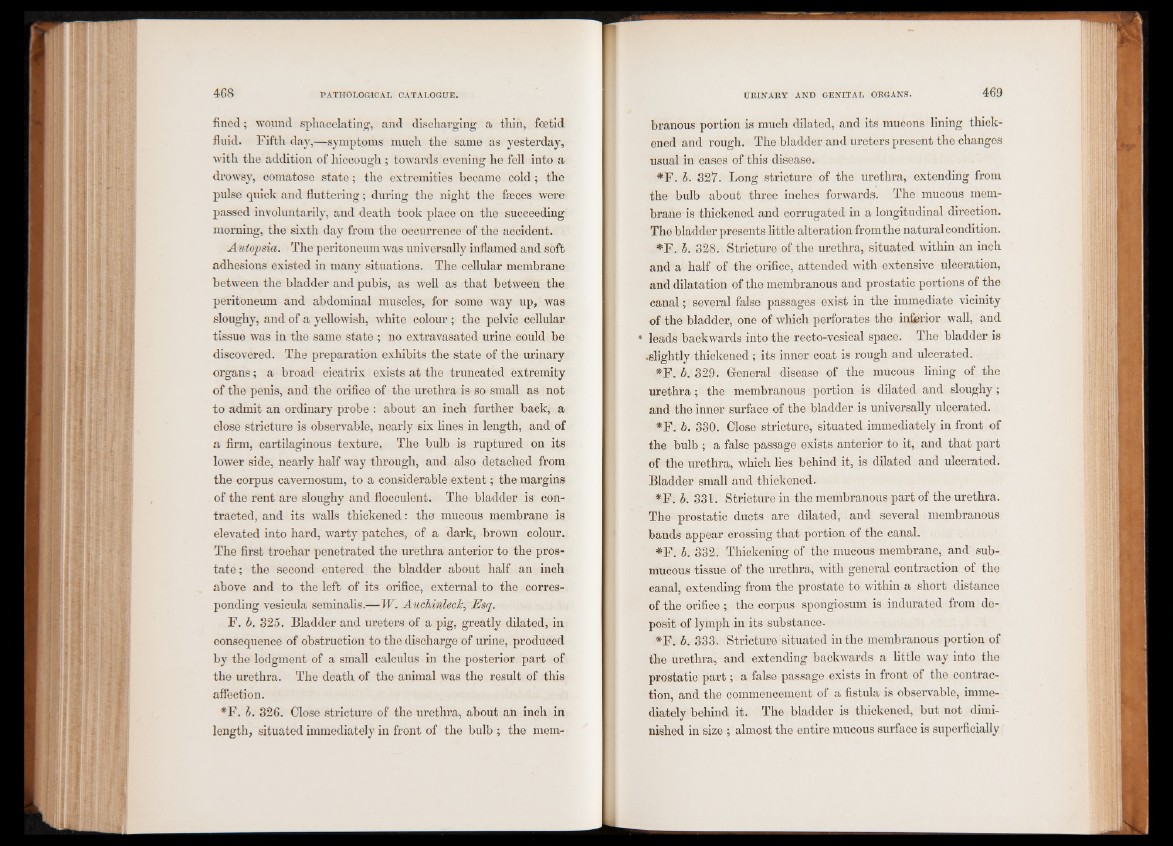
fined; wound sphacelating, and discharging a thin, foetid
fluid. Fifth day,—symptoms much the same as yesterday,
with the addition of hiccough ; towards evening he fell into a
drowsy, comatose state; the extremities became cold; the
pulse quick and fluttering; during the night the feeces were
passed involuntarily, and death took place on the succeeding
morning, the sixth day from the occurrence of the accident.
Autopsia. The peritoneum was universally inflamed and soft
adhesions existed in many situations. The cellular membrane
between the bladder and pubis, as well as that between the
peritoneum and abdominal muscles, for some way up, was
sloughy, and of a yellowish, white colour; the pelvic cellular
tissue was in the same state ; no extravasated urine could be
discovered. The preparation exhibits the state of the urinary
organs; a broad cicatrix exists at the truncated extremity
of the penis, and the orifice of the urethra is so small as not
to admit an ordinary probe : about an inch further back, a
close stricture is observable, nearly six lines in length, and of
a firm, cartilaginous texture, The bulb is ruptured on its
lower side, nearly half way through, and also detached from
the corpus cavernosum, to a considerable extent; the margins
of the rent are sloughy and flocculent. The bladder is contracted,
and its walls thickened: the mucous membrane is
elevated into hard, warty patches, of a dark, brown colour.
The first trochar penetrated the urethra anterior to the prostate;
the second entered the bladder about half an inch
above and to the left of its orifice, external to the corresponding
vesicula seminalis.—W. Auchinleclc, Esq.
F. b. 825. Bladder and ureters of a pig, greatly dilated, in
consequence of obstruction to the discharge of urine, produced
by the lodgment of a small calculus in the posterior part of
the urethra. The death of the animal was the result of this
affection.
*F. b. 326. Close stricture of the urethra, about an inch in
length, situated immediately in front of the bulb ; the membranous
portion is much dilated, and its mucons lining thickened
and rough. The bladder and ureters present the changes
usual in cases of this disease.
*F. b. 327. Long stricture of the urethra, extending from
the bulb about three inches forwards. The mucous membrane
is thickened and corrugated in a longitudinal direction.
The bladder presents little alteration from the natural condition.
*F. b. 328. Stricture of the urethra, situated within an inch
and a half of the orifice, attended with extensive ulceration,
and dilatation of the membranous and prostatic portions of the
canal; several false passages exist in the immediate vicinity
of the bladder, one of which perforates the inferior wall, and
• leads backwards into the recto-vesical space. The bladder is
•slightly thickened; its inner coat is rough and ulcerated.
*F. b. 329. General disease of the mucous lining of the
urethra; the membranous portion is dilated and sloughy;
and the inner surface of the bladder is universally ulcerated.
*F. b. 330. Close stricture, situated immediately in front of
the bulb ; a false passage exists anterior to it, and that part
of the urethra, which lies behind it, is dilated and ulcerated.
Bladder small and thickened.
*F. b. 331. Stricture in the membranous part of the urethra.
The prostatic ducts are dilated, and several membranous
bands appear crossing that portion of the canal.
■ H b. 332. Thickening of the mucous membrane, and submucous
tissue of the urethra, with general contraction of the
canal, extending from the prostate to within a short distance
of the orifice; the corpus spongiosum is indurated from deposit
of lymph in its substance-
*F. b. 333. Stricture situated in the membranous portion of
the urethra, and extending backwards a little way into the
prostatic part; a false passage exists in front of the contraction,
and the commencement of a fistula is observable, immediately
behind it. The bladder is thickened, but not diminished
in size ; almost the entire mucous surface is superficially